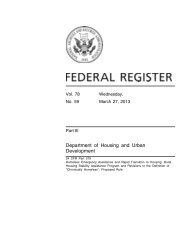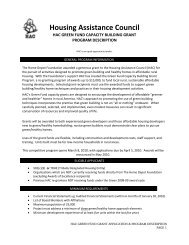Public Relations Guide for Rural Housing Organizations (manual
Public Relations Guide for Rural Housing Organizations (manual
Public Relations Guide for Rural Housing Organizations (manual
Create successful ePaper yourself
Turn your PDF publications into a flip-book with our unique Google optimized e-Paper software.
Media AdvisoryA media advisory tells press outlets about an event in advance so reporters can plan to be thereand editors can plan <strong>for</strong> a story. Do not assume that the media will pick up on news of yourevent by word-of-mouth or general knowledge. Think of the advisory as being a simple factsheet that will communicate all of the essential in<strong>for</strong>mation, much like an invitation.It is very important to follow the standard <strong>for</strong>mat <strong>for</strong> a media advisory. Use, in bold, thefollowing headings <strong>for</strong> your in<strong>for</strong>mation.- What (event)- Where (place)- Who (speakers, organization)- When (time)Beneath each heading should be a brief summary giving only the facts. The <strong>for</strong>mat should notbe a narrative.The advisory should be on your organization’s letterhead with the words “Media Advisory”prominently displayed near the top. The media advisory may be distributed via e-mail or fax.It should be sent out well be<strong>for</strong>e the event.Include contact in<strong>for</strong>mation – <strong>for</strong> example, “Jane Doe, 123-456-7890,jdoe@communityorg.org.” End with one of the traditional ways to end a press release oradvisory: “-30-“ or “###.” An advisory should never be more than one page. (See the samplein Appendix A.)Be sure that the advisory goes to all news organizations in your area; do not second-guesswhich media will give you coverage. This is not the time to alienate one news organization infavor of another. If appropriate, include any news services that cover your community.CameraDigital cameras facilitate the transmission of photographs electronically as attachments to e-mail messages. This is especially helpful to the media and is by far the fastest way of gettingphotographs to the press. Note standard <strong>for</strong>mat preferences and that the quality must be high<strong>for</strong> the photo to be published.Offer photos to your media contacts, perhaps especially to those who did not attend an event.A reporter can write an article based on a press release and an interview, sounding as if s/heattended the event and using a photo you provided.According to Sharon Walden of Welch, W. Va., you should always have your camera ready, anduse it often. Sharon believed that the representative of a foundation lifted a five-year limit onthe length of a current grant because she spontaneously used her camera. Sharon took aphotograph of the representative during his visit to her organization and then used it to write a20 <strong>Public</strong> <strong>Relations</strong> <strong>Guide</strong>









